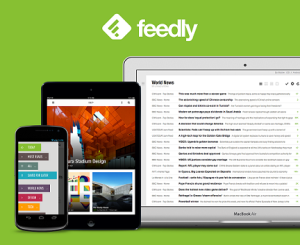Each month the TEL team will be introducing you to a useful resource and this time it is Feedly; the app that allows you to bring together everything you regularly view on the web.
Feedly is an app that allows you to collect, read and share new content from your favourite websites, blogs and feeds. It works like an RSS (Really Simple Syndication) collection service for all the content you usually view on the web. RSS allows for people to subscribe to a webpage and have the information from that page sent to them, rather than having to manually visit the page themselves every time they want to be updated on its content. In this way, Feedly makes the web come to you, either through the app or through a web browser, rather than you having to go to the web.
The Feedly app allows you to:
- Subscribe to RSS feeds to update you from your commonly used sites, blogs and feeds
- Bookmark and save articles to read later
- Share articles easily via email or SMS and on social networking sites (e.g. Twitter, Facebook, Google+)
- Use the Buffer integration to schedule when articles are shared on social media.
Ideas for using Feedly in learning and teaching
- Review content – perhaps the most obvious way of using Feedly in learning and teaching is as a tool to allow students to review content. Feedly will allow for a fresh process to researching and reviewing content, different from (but still complementary to) the more traditional approaches.
- Compare and contrast opinion – as Feedly allows for students to gain a plethora of opinion on a small subject, it can be used to encourage students to evaluate information and compare different perspectives.
- Encourage wider reading – Feedly can be used as a way of encouraging students to read around their subject and gain updated information on the state-of-the-art in their field.
- Use real world examples – using the share feature, you can share any real world examples of an authentic concept that may have been discussed in class. This allows the student to contextualise their learning and see potential impact of their studies.
- Real-time discovery – as Feedly collates and updates in real-time, students can use it to follow events in real-time, map reporting and keep up to date with changing perspectives and opinions.
Is it free?
Feedly is a free service that you can sign up to through your Google, Facebook or e-mail account. You can upgrade this service to Feedly Pro which offers a few more services (e.g. integration with DropBox, LinkedIn, HootSuite) but there is a cost attached.
Will it work on my device?
Feedly will work on Apple (iPhone, iPad, iPod touch) and Android devices. The Apple devices requires iOS 6.0 or later and the Android devices require Android 2.2 or later. The app is currently not available on Blackberry.
Where can I get the app?
The app is available from the App Store or Google Play.
What are the alternatives?
Here are some alternatives to Feedly you may want to look at. None of them have quite the same functionality, but each does some similar things:
- Readily
- Inoreader
- Newsblur
- Digg reader
If you would like help with using Feedly or to discuss how this or any other mobile app could help you in your teaching or learning please get in touch with the TEL team.




[…] Learning Network) by following other academics’ blogs using a service like Feedly (see our post on Feedly).” To read further please click here: […]